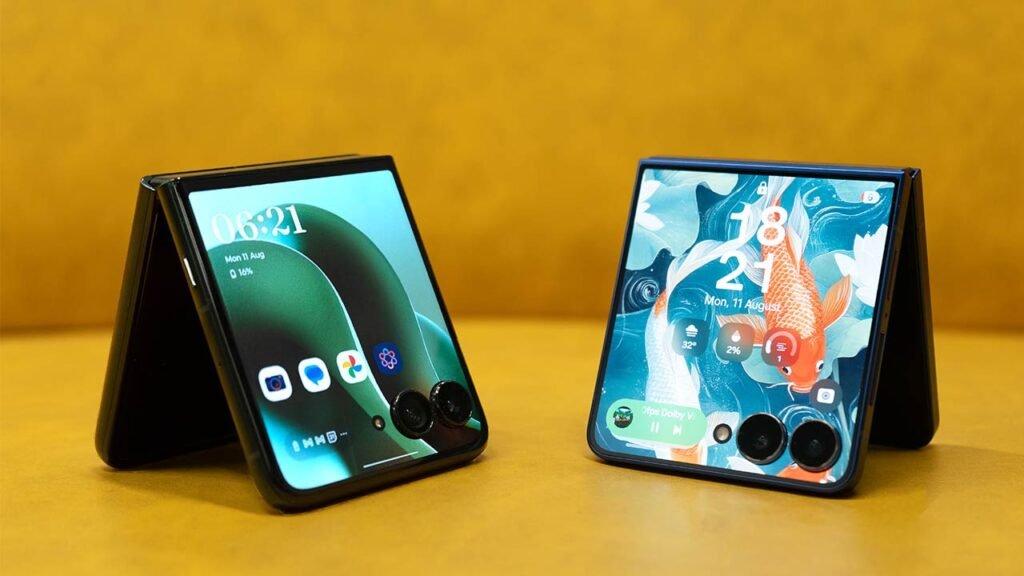The flip phone renaissance is in full swing, and 2025 might just be its most exciting year yet.
Samsung’s seventh-generation Z Flip 7 and Motorola’s Razr 60 Ultra are two of the best examples of how far the category has come.
Both take the core idea of a compact, foldable smartphone and dress it up with flagship specs, innovative designs, and surprisingly practical features.
But which one nails the formula better? Let’s unfold the details.
Design and Build
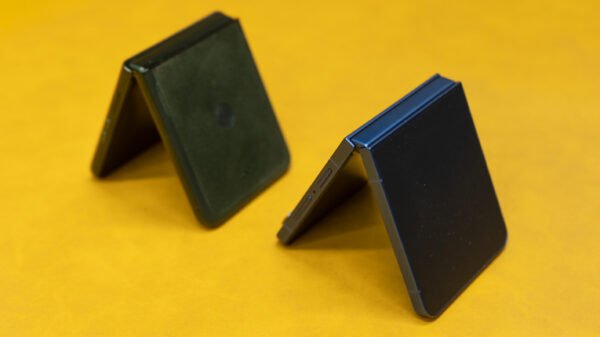
Motorola clearly decided to go for a tactile and premium feel this year.
The Razr 60 Ultra’s Alcantara and FSC-certified real wood back make it stand out in a sea of glass-and-metal phones.
Also Read: Samsung Galaxy Flip 7 Review: To Flip or Not to Flip?
It’s not just about looks either; the texture makes it more grippy, and at 199g, it feels lightweight for a device this powerful.
The titanium hinge is smooth, durable, and the crease on the main screen is barely noticeable.
Samsung’s Z Flip 7, on the other hand, doubles down on sturdiness.
Its hinge is notably stronger and more confidence-inspiring than Motorola’s, with a reassuring resistance when you open and close it.
While Samsung opts for a more conventional glass finish, it still looks sleek and stylish, though it lacks the warm, tactile character of the Moto.
Both phones carry IP48 water resistance ratings. Dust protection still isn’t perfect for either, so beach trips and sandy hikes are still a bit risky.
Displays
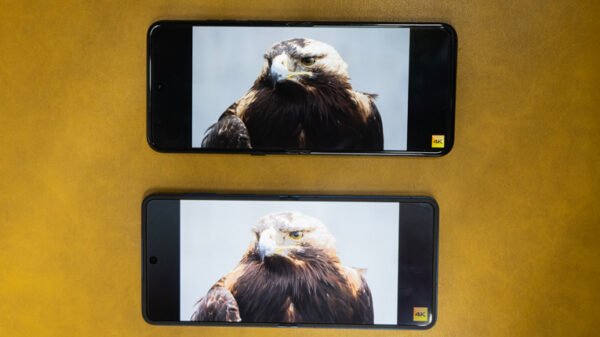
On paper, both phones have stunning foldable AMOLED main displays.
Motorola’s is slightly bigger at 7 inches with a sharper 1224 x 2912 resolution and a blistering 165Hz refresh rate.
It also boasts an astonishing 4500 nits of peak brightness, making it an absolute joy outdoors.
Samsung’s 6.9-inch Dynamic AMOLED 2X panel maxes out at 120Hz, but it’s no slouch.
Colours are vibrant, motion is fluid, and the 2600 nits peak brightness is more than enough for sunny days.
The crease is visible but, like Moto’s, easy to forget after a while.
Where it gets interesting is the outer display.
Last year, Motorola’s larger cover screen gave it a clear advantage over Samsung.
This year, the Z Flip 7 finally catches up, adopting a corner-to-corner 4.1-inch panel that, like Moto’s 4-inch LTPO AMOLED, can run full apps, reply to messages, start navigation, and even play videos without flipping the phone open.
Both outer displays are bright, responsive, and far more than glorified notification windows.
Performance and Software
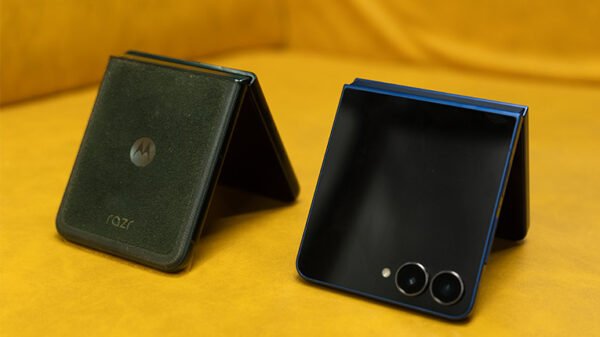
Under the hood, Motorola takes the crown for raw specs.
The Snapdragon 8 Elite (3nm) is Qualcomm’s current best, paired with a huge 16GB of RAM and 512GB of storage.
It chews through multitasking, gaming, and heavy photo editing without breaking a sweat, and it stays cool while doing so.
Samsung’s Z Flip 7 runs on the Exynos 2500 (3nm) with 12GB RAM and the same storage option.
Performance is solid for daily use, with smooth animations and quick app launches.
It handles games like Call of Duty: Mobile well, though it warms up under sustained load more than the Moto.
Both devices run clean, optimised software with foldable-specific tweaks.
Motorola’s Android 15 build is bloat-free with a handy AI button for quick smart features.
Samsung’s One UI 8 is loaded with refinements, including AI-assisted tools like transcription, Circle to Search, and improved multitasking, but it still locks some outer display functions behind the Good Lock plugin, which feels unnecessary.
Cameras
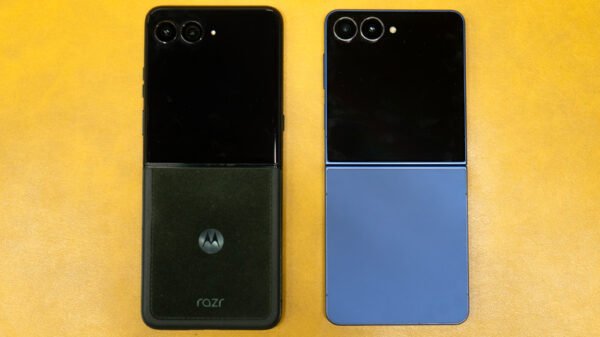
Here’s where Motorola pulls ahead by a big margin.
The Razr 60 Ultra packs two 50MP sensors, both delivering excellent detail, colour accuracy (Pantone-validated), and strong low-light performance.
Portrait mode is sharp with clean separation, and selfies from the 50MP front camera are crisp.
Samsung’s Galaxy Z Flip 7 has a 50MP main and 12MP ultra-wide setup.
While it captures decent shots in good light, it struggles with detail retention and dynamic range.
Shadows often lose information, and mixed lighting conditions cause exposure inconsistencies.
Low-light images are brighter thanks to Night Mode, but noise is an issue.
The 10MP selfie camera is serviceable but rarely needed when you can use the outer screen to frame shots with the main camera.
For anyone prioritising photography in a flip phone, the Moto is clearly the better choice.
Battery Life
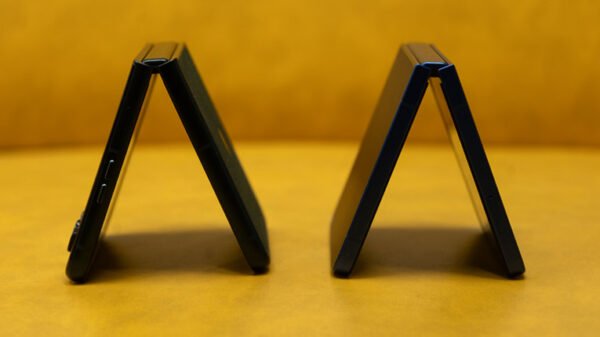
Both phones perform well here. The Razr 60 Ultra packs a 4700mAh battery, which is the largest in the flip category right now.
It comes with 68W wired and 30W wireless charging.
It easily lasts a day and a half with moderate use, and just 8 minutes on the charger gives you a full workday’s juice.
The Z Flip 7’s 4300mAh cell isn’t far behind for endurance, consistently lasting a day, but charging speeds are slower at 25W wired and 15W wireless.
It’ll still get you through a typical day, but you’ll need to plug in earlier if you push the camera or gaming hard.
Bottom Line
Here’s where things get interesting.
The Motorola Razr 60 Ultra retails at ₹90,000, undercutting Samsung’s ₹1,10,000 Z Flip 7 by a full ₹20,000.
That’s a significant gap, especially when Moto offers a better camera system, higher refresh rate display, faster charging, and more RAM.
Samsung still offers better hinge durability and the polish of its One UI ecosystem, but the value proposition tilts heavily toward Motorola for anyone who doesn’t mind a slightly less sturdy hinge.


